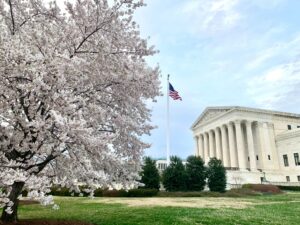SCOTUS allows landowners’ suit against the federal government to move forward

Last week, in an opinion authored by Justice Sonia Sotomayor, the Supreme Court ruled in favor of PLF clients Wil Wilkins and Jane Stanton.
Wil and Jane, two Montana homeowners, sued the federal government after the Forest Service tried to expand an easement the agency holds over Wil and Jane’s property. The previous homeowners had granted the Forest Service limited permission to cross the private property to access the National Forest, allowing Forest Service officials and some Forest Service license holders to use the road. But in the past decade, the Forest Service invited anyone to use the road, which resulted in the public speeding along the road, trespassing on Wil and Jane’s properties, people shooting guns in and around their houses (one person even shot Wil’s cat) and other nuisances along the road.
Wil, Jane, and their neighbors reached out to the Forest Service for help, but the agency responded that it could allow anyone it wanted to use the road, and it had no obligation to address the problems caused by those it invited to use the road. Faced with no other choice, Wil and Jane (represented by PLF) sued the federal government under a statute known as the Quiet Title Act, alleging that the Forest Service could not allow anyone to use the road, and that it was responsible for ensuring that those who use the road do not cause problems.
The district court, however, did not decide what the easement says. Instead, it dismissed the case before Wil and Jane could have their day in court. The court dismissed the case by strictly interpreting the Quiet Title Act’s statute of limitations—that is, the time limit that one has to file a case. The Quiet Title Act requires a landowner to bring a case within 12 years of when he or she “knew or should have known” of the government’s claim in the land.
In Wil and Jane’s case, the government had managed the road for limited use for decades, and then, when problems arose, Forest Service officials told Wil that the agency would be closing the road entirely and that he did not need to worry about it. But eight years after that conversation, the Forest Service reversed course and officially decided to open the road to the public. When Wil and Jane sued, the Forest Service argued that they had waited too long to file the suit.
The district court bought the government’s argument without giving Wil and Jane the opportunity to present all the evidence about why they did not file the case earlier. The court held that the statute of limitations was “jurisdictional”—in other words that it must be strictly applied and can be decided without a trial, and that there are no exceptions to the time limit.
Whether a time limit is jurisdictional or not may seem technical, but the Supreme Court has said that “the distinction matters.” A jurisdictional rule “alters the normal operation of our adversarial system,” as seen in Wil and Jane’s case. Because the district court held that the rule was jurisdictional, Wil and Jane could not even present all of their evidence before the court, and they were unable to argue that any delay in their filing was a result of the Forest Service telling them that they did not need to file a lawsuit to resolve their problems.
Fortunately, the Supreme Court disagreed with the district court and held that the Quiet Title Act’s statute of limitations is not jurisdictional. As a result, Wil and Jane will have their day in court, and will be able to present all the evidence they have about the government’s actions in this case, as well as their argument about why the government is not adhering to their agreement about using their property to access the National Forest.
But the Supreme Court’s decision is not just a win for Wil and Jane; it is a win for property owners across the nation. The decision will make it harder for the government to use procedural rules to avoid having property owners’ claims decided.
The Wilkins decision follows the Court’s recent trend of telling lower courts that they should decide more cases against the government on the merits, rather than avoiding the issues on procedural grounds. Many of these Supreme Court cases were brought by PLF’s clients: Sackett I, Hawkes, Knick, Pakdel. In all of these cases, the government tried to use procedural rules to prevent the court from adjudicating individuals’ claims against the government. But in these cases, the Supreme Court rejected these procedural blocks and told the lower courts to decide the case on the merits.
The three dissenting Justices in Wilkins, in an opinion authored by Justice Clarence Thomas, took a stricter view of the Quiet Title Act’s statute of limitations and an individual’s ability to sue the government. The dissent focused on the concept of sovereign immunity, which is a doctrine that one cannot sue the government without the government’s consent. Sovereign immunity arises from English common law and the belief that “the King can do no wrong.” The dissenting Justices believed that a waiver of sovereign immunity—like the waiver in the Quiet Title Act—must be interpreted narrowly and, thus, concluded that the Quiet Title Act’s statute of limitations is not jurisdictional.
The concept of sovereign immunity is at odds with the Constitution’s protection of individual liberty. When the Senate Committee on Interior and Insular Affairs originally proposed the Quiet Title Act, it said, “Sovereign immunity or the infallibility of the Crown, so to speak, became imbedded in the common law of England and so came into our American law. However, the committee believes this principle is not appropriate where the courts are established, not for the convenience of the sovereign, but to serve the people.” In order to properly serve the people and protect individual liberty, courts must not prematurely dismiss cases against the government. In deciding for Wil and Jane, the Supreme Court once again asserted this principle, to the benefit of all Americans.








